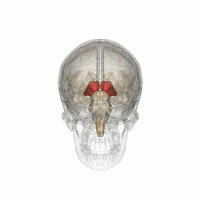This post is a hasty effort to simplify and pinpoint important but not always easily available/understandable facts of the topic for less initiated readers. It's a messy posting for sure but Klevius might continue improving it if you so wish.
The most important artifact ever found when it comes to understanding human evolution
This extremely complicated to manufacture stone bracelet was possibly made by the "non-human(?) Denisovan hybrid in Siberia >40,000 years ago by utilizing drilling/polishing technologies comparable to modern machines, according to the researchers who found it. It's authenticity and age has recently (again) been confirmed with newest methods. It's a complete mystery - unless you combine it with the fact that it was found in the only place known to have been populated by three different Homos of whom we have also have complete genetic material. Because Denisovan traits are most common in contemporary SE Asia (Papua, Australia, Melanesia etc) Klevius has proposed a scenario where an island dwarfed brain (compare Homo floresiensis) has genetically "escaped" to mainland Asia during a period of low sea level and there mixed with mainland Homo populations up to the big headed northern pops. and thereby caused a revolution in intelligence.* Mongoloid cold adaptation is one of the most contentious areas in anthropology and one that is most likely to be biased because it not only challenges the completely unsubstantiated "out-of-Africa" myth - it makes it theoretically impossible because Africa has never had the preconditions necessary for the development of mongoloid features. So why do people even talk about it anymore? Modern humans couldn't have evolved in the Americas (oldest signs of human after 15,000bp, geography, and the lack of apes, to mention just a few) yet Americans seem to have no problem not being the "cradle" of humans. Even the term 'modern' is misplaced because there were no 'humans' before - unless you count bipedal apes as such. But why would you? Even the most intelligent bipedal ape, the Neanderthal, was a universe from the Denisova bracelet which is the first (so far found) sign of modern human intelligence (do note that we know almost nothing about its creator's appearance - could even have looked worse than the Neanderthal). Also, do note that although intelligence was what made us humans, lack of intelligence doesn't mean lack of Human Rights - or just 'rights' if you like! It's already criminal to abuse a chimp but within a certain UN sanctioned (OIC's sharia declaration) racist/sexist ideology it's just fine to abuse girls, women and so called "infidels".
However, most bias use a particular conceptualization of the term 'mongoloid' to boost a certain angle of view. Cold adaptation, on the other hand, is a quite agreed on condition. So wherever you see mongoloid traits they must have been derived from northern Eurasia, no matter how diluted or mixed (San in southern Africa retain a lot of mongoloid traits despite being heavily mixed with Bantu speakers through slavery etc).
Although you can find cold places at higher altitudes more to the south those areas aren't nearly as good food resources as river areas in the north.Which fact leaves us in the north.
Mongoloid features are e.g. the "Lewis waves" of warm blood cyclical vasodilation and vasoconstriction of the peripheral capillaries, short limbs, short nose, flat fat face with epicanthic fold and lower surface to mass ratio. The high and narrow nose of Eskimos and Neanderthals is an adaption to a cold and dry environment since it contributes to warming and moisturizing the air and the recovery of heat and moisture from expired air. An experiment on the survival of rats in the cold found the rats with narrow nasal passages, broader faces, shorter tails and shorter legs survived the best in the cold. Arctic mongoloids have similar features: A narrow nasal passage, relatively large heads, large jaws, relatively large bodies but short limbs.
The indigenous people of the Americas vary because of the warmer climate they encountered on their way south after they had cold adapted in Siberia. This pattern is both similar and different to those in warmer parts of Asia. Different because whereas the Asian mongoloids encountered southern non-mongoloids, the first Americans didn't meet with anyone.
"Racial" distribution in accordance with Klevius' "Out of Siberia and back to Africa" theory (aka "Out of Africa as pygmies and back as global mongoloids" before the discovery of Floresiensis and Denisovan).
Mongoloids and Australoids are the races most distant from each other because whereas Africa had a strong back migration of mongoloids Australia due to its location came to be less involved. This is also why the so called Caucasoid race (in a broad sense) came to populate what in Klevius terminology is called the "bastard belt" (the grey area on the map).
Mongoloid Shompen (highest, i.e. 100% of O blood type together with Bororo, Peru while their neighbors have the lowest) in tropical SE Asia (Andaman Nicobar Islands) resemble many South-American tribes. Interestingly their language isolate has similarities in syllable construction with such Altaic rooted languages as Finnish and Korean. Shompen is unrelated to Nicobarese, an isolated group of Austroasiatic languages, spoken by nearby Negritos.
Moreover, American natives arrived some 25,000 years after the emergence of those behind the Aurignacian revolution in Eurasia. And long before the birth of modern humans in Siberia/Altai, the population of Eurasia was already divided in a more "mongoloid" Homo erectus type in the east and a more apelike Heidelbergensis and Neanderthalensis in the west. The latter because of the old ape influence from Africa. In the east e.g. Dali and Jinniushan (210,000-260,000bp) show a very straight and flat face, the latter with a female brain volume of almost 1,400cc.
The first physically fully modern humans (Homo sapiens sapiens) have been found in China.
This remarkable skull is covered by Wikipedia in two short sentences: "The Liujiang men are among the earliest modern humans found in East Asia. Their remains were discovered in the Tongtianyang Cave in Liujiang County, Guangxi, China."
The dividing lines used to separate modern humans from archaic Homo sapiens and archaics from Homo erectus are unclear.
However, there is no reason (other than Africa-centrism) to consider "archaics" (i.e. bi-pedal apes with less prominent canines and more prominent brain case) and modern humans as belonging to the same species.
No wonder ignorant people believe in the incredibly stupid "out-of-Africa" and "African Eve" myths. Reminds Klevius of the equally stupid, religious "big-bang" "theory" created by a Catholic cleric to make "creation" sound cooler and eagerly picked up by the "god" people. Sorry, what did you say? Klevius rude!? On the contrary, Klevius tries to pave the way for a better understanding of the importance of Universal Human Rights equality for everyone instead of racism and sexism sneaking in under the dirty cover of "faith". And for that purpose things have to be called by their proper names so to hinder further confusion.
Scandinavians are the earliest Europeans - but why don't they look mongoloid?
Simply because modern humans originated in Siberia/Altai, not in Africa. So when modern humans (no, they didn't look like most Scandinavians today) spread out from Siberia they filled what wasn't under ice (Scandinavia was mostly under ice). In doing so they encountered and hybridized with archaic homos, especially in the more populous southern parts. After the ice-age, mainly the northernmost groups, i.e. least affected by southern (non-refuge) groups, peopled the Fenno-scandian peninsula.Later waves from the east mixed and physically change the Scandinavian appearance while retaining most old genes in the parts least affected by the neolithic.If "out-of-Africa" is the most politically correct positioning, the most incorrect one must be German Diezel's "out-of-Americas". At least based of geography. And the most moderate one Klevius' "out-of-Siberia".
100% of popular media still resides in Africa while a rapidly increasing number of the world's anthropologists are leaving but without really knowing whereto. Except for Dziebel who ended up in the Americas and Klevius who stayed with the mongoloids in Siberia who became "Caucasoid" due to mixing with non-mongoloid archaic Homos.
However, whereas Dziebel's out-of-Americas seems to get a lot of reactions, Klevius' out-of-Siberia gets none despite the fact that both artefacts (Denisova bracelet etc) and genetics seem to best support Siberia/Altai. Moreover, unlike everyone else Klevius also tops the cake with a logical hypothesis (Floresiensis/Denisovan connection) consistent with what we know so far.
Roebroeks and his colleague, Dr Paola Villa at the University of Colorado Museum in Boulder, trawled through the archaeological records to look for evidence of modern human superiority that underpinned nearly a dozen theories about the Neanderthals' demise and found that none of them stood up.
"We found no data in support of the supposed technological, social and cognitive inferiority of Neanderthals compared to their modern human contemporaries," said Wil Roebroeks, an archaeologist at the Leiden University in the Netherlands.
"The explanations make good stories, but the only problem is that there is no archaeology to back them up,"
"The evidence for cognitive inferiority is simply not there," said Villa. "What we are saying is that the conventional view of Neanderthals is not true."
Klevius comment: No not at all, it's the conventional view on the modern human that isn't true! And the reason for that is the fanatic push for the unfounded "out-of-Africa" myth which has been kept alive by squeezing in non-human fossils under the laughable title "anatomically modern human". And the only reason seems to be racist African-centrism aided by a "let's call the most backward continent the origin of humanity". In fact, it was Arabic islam that made Africa backward for 1400 years with its racist/sexist "infidel" slave raiding/trading!
Klevius wrote:
Friday, May 02, 2014
Klevius Out-of-Siberia theory again gets strong support - while news media misinform and confuse
Yes, there was no big difference in intelligence between Homo sapiens and Homo neanderthalensis - until something big happened in cold Siberia/Altai
Here's a blatantly false and misleading "news" story
And here's a more accurate one
Klevius explanation: The keyword is 'early' in 'early modern humans'. This 'early' was missing from Guardian's reporting which then gives the impression that Neanderthals were equally clever as we. They were not, and this is extremely clear from what we know so far about their material culture. However, from the perspective of Klevius' theory (see below) this is really the crucial point that Klevius has challenged since he published his book Demand for Resources - on the right to be poor in 1992 (admittedly not a big hit) where he questioned why big brained Homos (e.g. the 1,400cc female Jinnuishan skull) living in China more than 200,000 bp didn't manage to leave more and better cultural traits than they actually did.
A brief summary of Klevius' theory with some remarks on racial etc bias
For some twenty years Klevius has proposed the view that modern humans got a small but more efficient brain in the south (jungle?) but that they peaked culturally in the cold and challenging but also rewarding north where they got a bigger brain by mixing with pre-existing Homos. Neanderthals contributed with big skulls and erectus with mongoloid traits. We do know that Floresiensis possessed a brain that was much smaller than erectus' brain yet managed to produce similar culture. What is today called Indonesia happened to have the perfect breeding environment for the brain experiment that produced both Floresiensis and Denisovan: Jungles which, due to sea level changes, altered between islands and mainland. When mainland Floresiensis/Denisovans mixed with erectus (Red Deer Cave people might have been such a hybrid) they improved the brain qualities of erectus while getting erectus' mongoloid traits for cold adaptation (assuming erectus got it in their initial expansion to the north as well) and later on brought it south). Somewhere in the Altai region they also encountered northern Neanderthals which further enlarged their heads and produced a very smart modern human (compare the Denisova bracelet) which then started a successful back migration in all directions which strengthened the mongoloid traits in the already mongoloid east while mongoloid traits were diluted when mixing with non-mongoloids in the west and southwest (Neanderthal and archaic sapiens hybrids) and later on by the neolithic expansion. This explains the general racial pattern and also why we have "skinny" mongoloids both in the south and north although the original northern mongoloid were presumably "fatty" for the cold (compare Venus figurines, steatopygia etc).
Klevius personal note: It's extremely important to distinguish between PC cultural "race" terms and evolutionary traits. I call myself as belonging to the "bastard race", i.e. not a Saami, Scandinavian, Finn or Swede, but with a lot of mongoloid genetic traits in common with them or their predecessors. With a dad born in Gothenburg and a Finnish mother born in Helsinki who delivered me in Stockholm, and with a bilingual upbringing in Finland to a culturally ethnic Atheist Finland-Swede working in both Finland and Sweden, I rather emphasize my ethnicity under the 1948 Universal Human Rights declaration. Which fact effectively keeps my logic out of sexist and racist ranting about my ethnicity/race that would otherwise make it more difficult to produce scientific theories in this field.
Funny, but somehow I never even reflected over other "races" as being "inferior" or "different" as human beings or anything before these self-declared cultural "races" themselves started implying that I also possessed a "race" and that that "white" "race" was a "racist" "race". Had no idea really and in the 1990s while living in Finland and after visiting some "black" and "colored" Swedes in Stockholm our child thought Swedes were black in general.
Higher ape/hominid evolution in continental Africa vs. island SE Asia
Already before the discovery of Homo floresiensis Klevius thought a good "pygmy" brain slowly traveled to the protein rich but cold north while increasing in size and capabilities. After the discovery (2004) of the apelike and extremely small brained but smart Homo floresiensis in southern Indonesia nothing except M130 connected anything to Africa anymore. And when the Denisovan was discovered in Siberia at the same place as the hitherto most sophisticated early artifact ever found (Denisova bracelet - see above) the picture seemed quite clear. There are only two possible places for equatorial evolution of hominids, either Africa or SE Asia. And because SE Asian archipelago offers the by far best combination of jungle isolation and changing barriers it seems that floresiensis (and similar populations) should have been equally expected as the dwarfed elephants they hunted.So when a floresiensis like population managed to escape to mainland Asia they started mixing with local Homo erectus all the way up until they met with the northern Neanderthals and there created what became the truly modern humans - overwhelmingly proven through stunning skills revealed in unprecedented art and behavior.
M130
Sima de los Huesos, Floresiensis and Denisovan
may have all originated in EurasiaGenetic evidence reveals that the Sima de los Huesos hominin (400,000 bp) shared a common ancestor with Denisovan some 7-800,000 bp rather than with Neanderthal although its skeletal remains carry Neanderthal-derived features.
Do note the lack of chin in these as well as in the 26,000 bp Venus of Brassempouy. Also note that we don't know the shape of Floresiensis' nose.
The Sima sample exhibits a number of features that are shared with Neanderthals but not African fossil humans, and are rare in recent humans.
Later Neanderthals do not have the same diversity as earlier Neanderthals in western Europe, while central Asian Neanderthals have more diversity than those from Europe. This may indicate that Neanderthals were more numerous in western or central Asia.
The Denisovan nuclear DNA is also closer to Neanderthals than the Denisovan mtDNA.
Sima de los Huesos is closely related to the lineage leading to mitochondrial genomes of Denisovans.
The Denisovan-heidelbergensis clade split about 800kya-900 kya (around the time of the oldest stone tools on the island of Flores where floresiensis was found) is older than the modern human-Neanderthal split. Non-African Homo has an Erectus connection, a Denisovan-heidelbergensis connection, as well as a Neanderthal connection.
For a background to Klevius' theory see previous postings and Out of Africa as Ape/Homo hybrids and back as global Mongooids
First and third from the left are Red Deer Cave people 14,300-11,500 years ago. Second and fourth the so called Venus from Brassempuoy in France 25-26,000 years ago. The last pic is a reconstruction of a 1.9 Million year old Homo rudolfiensis skull. They all had flat broad cheeks, no chin and rounded forehead.
From the left: Red Deer Cave, Sami, Cro-Magnon
Was the sculptural portrait of Venus of Brassempuoy made because she looked so different from Cro Magnon? Was she kept as a pet or something by her Cro Magnon captors?
There were certainly completely different looking modern humans living in Eurasia side by side some 26,000 years ago. And the only way to make sense of these enormous differences is Klevius hybridization theory, i.e. that the modern brain came from small ape-like creatures (compare the "scientists" who didn't believe that the small Homo floresiensis brain could be capable of tool-making, fire-making etc..
Venus of Brassempuoy, one of the world's oldest real portrait
(this one slightly retouched by Klevius)
 The
Red Deer Cave people, discovered in southern China and who lived some
14,300-11,500 years ago had long, broad and tall frontal lobes behind
the forehead, which are associated with personality and behavior.
However, they also express prominent brow ridges, thick skull bones,
flat upper face with a broad nose, jutting jaws and lack a humanlike
chin. Their brains were smaller than modern humans and they had large
molar teeth (just like Denisovan), and short parietal lobes at the top
of the head (associated with sensory data). According to Curnoe, "These
are primitive features seen in our ancestors hundreds of thousands of
years ago".
The
Red Deer Cave people, discovered in southern China and who lived some
14,300-11,500 years ago had long, broad and tall frontal lobes behind
the forehead, which are associated with personality and behavior.
However, they also express prominent brow ridges, thick skull bones,
flat upper face with a broad nose, jutting jaws and lack a humanlike
chin. Their brains were smaller than modern humans and they had large
molar teeth (just like Denisovan), and short parietal lobes at the top
of the head (associated with sensory data). According to Curnoe, "These
are primitive features seen in our ancestors hundreds of thousands of
years ago".  This Cro Magnon could have been the captor of Venus of Brassempouy.
Compare e.g. his protruding chin with the retracting one on Venus of
Brassempouy. And keep in mind that the human chin has been an elusive
and quite recent feature in human evolution. The delicate features we
used to attribute to anatomically modern human while simultaneously
attributing high intelligence may, in fact, not be connected at all.
Slender and delicate skeletal features are not always connected with
high cultural achievement. Quite the opposite when looking at skeletal
remains outside the Aurignacian area..
This Cro Magnon could have been the captor of Venus of Brassempouy.
Compare e.g. his protruding chin with the retracting one on Venus of
Brassempouy. And keep in mind that the human chin has been an elusive
and quite recent feature in human evolution. The delicate features we
used to attribute to anatomically modern human while simultaneously
attributing high intelligence may, in fact, not be connected at all.
Slender and delicate skeletal features are not always connected with
high cultural achievement. Quite the opposite when looking at skeletal
remains outside the Aurignacian area..Extreme Polarization among "experts" on human evolution
Here's a small taste bite from the house of anthropology/genetics:
Razib Khan (Gene Expression, discovermagazine.com): German Dziebel, the author of The Genius of Kinship: The Phenomenon of Kinship and the Global Diversity of Kinship Terminologies, does have two more Ph.D.s than I do, but I’m willing to bet he reads me a lot more than I read him! He might be a genius in a world of the insane. Or perhaps not. Dziebel likes to brandish his two doctorates and credential-smack people. His theoretical frame and models inferred are so strange and bizarre that it often takes energy to get at what he’s saying. To get a crisper image of Dziebel one has to know that he believes that modern humans derive from New World populations. Yes, that is not a typo. The peculiar thing in my experience with Dziebel is that he brandishes his theories as if he was a widely recognized singular genius who has the gravitas to speak ex cathedra on sundry topics. A major reason I banned him from this weblog is that he is highly persistent and prolific when he puts his mind to it, and totally immune to reciprocal interaction aside from that which might flatter his ego or theories. One of the major planks of Dziebel’s weblog seems to be to correct/attack/shadow other science bloggers, in particular myself and Dienekes. He assumes he knows all the details of my life, as well as of Dienekes’, and constructs scenarios and root causes of why we behave as we do. I know that this is the bread & butter of anthropologists, but since he hasn’t done fieldwork in the lab where I actually spend my days perhaps he should hold off on ascribing to me jealousy of real scientists like himself, who work in the trenches of marketing and advertising.Kostenki 14 genome (37,000 bp west of Ural/Russia) closer to Danes, Swedes, Finns and Russians than to Frenchmen, Spaniards and Germans. How come?
The genome of a 37,000-year-old male skeleton found in Kostenki in Russia represents a separate line from the forebears of present-day Asians. This is decisive when it comes to dating one of the most important events in history. It sets a line 37,000 years ago where the lines must have split, while the 45,000-year-old genome from Ust' Ishim in Siberia sets the limit in the other direction.
However,
Rasmus Nielsen from the University of Copenhagen and the University of California, Berkeley: "We can now date the separation time between Asians and Europeans." Compare this to Klevius' decade old adaptation from Wells' The Journey of Man. The dates are Wells' and based on now outdated methods.
Eske Willerslev, Director of the Centre for GeoGenetics at the University of Copenhagen: "From a genetic point of view Kostenki 14 (K14) is a European. Actually, he is closer to Danes, Swedes, Finns and Russians than to Frenchmen, Spaniards and Germans”. This gives the answer to one of the biggest questions in the history of mankind; i.e. that it is within an 8000 year gap that Europeans and Asians separated.
Instead of separate populations that had children within the group, Willerslev suggests one large meta-population consisting of several populations which mated with each other. The meta-population was connected through the neighbour's neighbours, consisting of people who generally resembled each other a lot, but who also had their own unique traits.
Tam-Pa-Ling skull 46-63,000 bp
Jaw from Tam Pa Ling in the Annamite Mountains, Laos, dating to between 46,000 and 63,000 ybp. Missing teeth mirrored by Klevius.
Eurasian complexity
Eske Willerslev: "It was a huge, complex network, and not separate branches that lived in isolation.” He believes the Europeans must have been one enormous meta-population stretching across Europe, the Middle East and Central Asia.
It is possible to follow the genetic trail; all the way from the Kostenki genome, to hunter-gatherers in Siberia 25,000 years ago and farmers 7-8000 years ago in Spain, Luxembourg and Sweden, up to present-day Europeans.
However, Johannes Krause from Eberhard Karl's Universität Tübingen in Germany and David Reich from Harvard University in the US, concluded that present-day Europeans descend from at least three separate groups.
David Reich acknowledges the importance of the new study, but is not convinced that it changes history very much.
"It's wonderful to have the Kostenki genome and it’s also important and interesting to find a degree of continuity from the population represented by Kostenki to present-day Europeans. On the basis of a statistical test or two, it's a pretty far-reaching conclusion as to how our history proceeded. However, it’s exciting - if it's true”.
Pontus Skoglund from Harvard University: "It'll be interesting to see more tests done, and as a field we need the time to digest these conclusions. But for now, it looks as though it may well be true, in which case it is an extremely important result."
It turns out that Scandinavians are more closely related to the Kostenki man than any other now-living population. This means that Scandinavians are the earliest Europeans.
However, the genome also indicates that many European traits, including those from the Middle East, were already present in the first Europeans.
Peter C. Kjærgaard, from Aarhus University: From a genetic point of view it makes no sense to categorise the Scandinavians as a separate people. In those days people didn't respect our virtuous, well-ordered ideas of belonging to specific groups.
I think this discovery, if anything, weakens the basis for any discussion about human migrations based on haploid genetics, and strengthens the case for discussion based on autosomal genetics.
Comments commented by Klevius
The SNP table shows that K14 did not belong to the same C as La-Brana, but rather a basal version of C1b, which is not present after him in Europe and is found in India, Oceania and East Asia if I'm not wrong.
So we have Ust-Ishim on the ENA line with a Yhap that roots him in East Asia, and another guy with WHG with a Yhap that roots him further east as well. And further south, because on his way here he grazed Basal populations.
Last of all we have Kostenki's skull, and it is not caucasoid in any sense, while the autosome is. East Asians may have branched into a separate population with its own Hg pool prior to any physical adaptation.
Modern human sub-Saharan populations exhibit the full range of root variation, from single and Tomes’ roots to mesiobuccal + distal and buccal + two lingual roots (9). Variation in root morphology is also observed in the third mandibular premolars [P3s in (2)] of Pan troglodytes verus (10).
Joshua Schraiber: "The main finding was that modern Europeans seem to be a mixture of three different ancestral populations". Schraiber said these results surprised him because the prevailing view among scientists held that only two distinct groups mixed between 7,000 and 8,000 years ago in Europe, as humans first started to adopt agriculture. Hunter-gatherers with olive skin and mainly blue-eyes first expanded upon the continent about 12,000 years ago, moving north with the retreat of glaciers at the end of the last Ice Age. Later, early European farmers from the Near East migrated west and mixed with the hunter-gatherers. Genetic evidence revealed these farmers had light-colored skin and brown eyes.
The third mystery group that emerged from the data is ancient northern Eurasians. "People from the Siberia area is how I conceptualize it. We don't know too much anthropologically about who these people are. But the genetic evidence is relatively strong, because we do have ancient DNA from an individual that's very closely related to that population, too".
Klevius take on some "mysteries"
Papuans and Melanesians are the most distinct from K14.
Oceanians are closer to Kostenki than to Stuttgart, and closer to Kostenki than to Mal'ta or Loschour.
Is it possible a Kostenki's pop. were part of an expansion from Oceania which simply hadn't had time to change much from the original source population while Suttgart, Mal'ta etc had had more time to develop adaptations to the local environment?
What divergent group contributed to Oceanians?
Did Papuans have admixture with a pre-sapiens SE Asian population? That explains the reasonably high Denisova element in them as well. And with Y-DNA K2(xK2a) apparently originating in SE Asia and K2b2 spreading around the world from there we have an explanation for:
"...Certain cranial features, including very narrow braincase, low and narrow face, marked prognathism (anterior protrusion of the midface), and very wide nose, are typical of tropical populations. The trait combination links the cranium with those of Papuans and Melanesians".
Why do San and Chinese have eye folds and Papuans don't?
Why do Ainu look like a lighter skinned cross between San and Papuans?
The Denisovan admixture was into an older human layer and it conferred an advantage over a later human layer allowing the mixed older layer to expand over the top of the later one.
A population in a tropical archipelago zone develops an advantage in the form of a better packed brain and expands outwards over mainland Asia.
After the ancestors of K14 admixed with Denisovans some returned to SE Asia/Oceania taking wives from locals.
Klevius' human evolution formula from hot to cold
Chimp/Homo hybridization (FOXP2 variant) + meeting/mixing with Eurasian Homos = Denisovan (Floresiensis type of island dwarfed brain case with a better packed brain?) and leaves an early but misleading genetic Africa label due to the back and forth movement between Eurasia and Africa.Denisovan (Floresiensis type of island dwarfing?) gets a better packed brain in island Indonesia through sea level isolation. Later on the opposite effect releases some of them into Asian mainland.
In summary, the oldest African genes are not human, and the later ones are just the result of mixing from back migration.
When Klevius in the 1980s got in contact with African aborigines he immediately was struck by their mongoloid appearance. Why on earth would African aborigines have traces of cold adaptation? Today we have the answer in Siberia.

































































































































































No comments:
Post a Comment